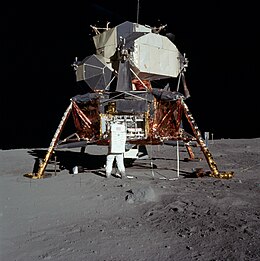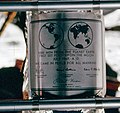Lunar Module Eagle
| Eagle | |
|---|---|
| Part of Apollo 11 | |
 Eagle on the Tranquility Base on July 20, 1969 | |
| Type | Lunar module |
| Class | Apollo Lunar Module |
| Manufacturer | Grumman |
| Specifications | |
| Launch mass | 33,294.5 lb (15,102.1 kg)[1] |
| History | |
| Fate |
|
 |
| Part of a series on |
| Apollo 11 |
|---|
|
Lunar Module Eagle (LM-5) is the spacecraft that served as the crewed lunar lander of Apollo 11, which was the first mission to land humans on the Moon. It was named after the bald eagle, which was featured prominently on the mission insignia. It flew from Earth to lunar orbit on the command module Columbia, and then was flown to the Moon on July 20, 1969, by astronaut Neil Armstrong with navigational assistance from Buzz Aldrin. Eagle's landing created Tranquility Base, named by Armstrong and Aldrin and first announced upon the module's touchdown.
The name of the craft gave rise to the phrase "The Eagle has Landed", the words Armstrong said upon Eagle's touchdown.[2]
Flight[]
Eagle was launched with command module Columbia on July 16, 1969 atop a Saturn V launch vehicle from Launch Complex 39A, and entered Earth orbit 12 minutes later.
Eagle entered lunar orbit on July 19, 1969. On July 20, Neil Armstrong and Buzz Aldrin entered into the LM and separated it from Command module Columbia.
Eagle was landed at 20:17:40 UTC on July 20, 1969 with 216 pounds (98 kg) of usable fuel remaining.
After the lunar surface operations, Armstrong and Aldrin returned to the Lunar Module Eagle on July 21, 1969.
At 17:54:00 UTC, they lifted off in Eagle's ascent stage to rejoin Michael Collins aboard Columbia in lunar orbit.
After the crew re-boarded Columbia, the Eagle was abandoned in lunar orbit. Although its ultimate fate remains unknown, some calculations by the physicist James Meador published in 2021 showed that Eagle could theoretically still be in lunar orbit.[3]
Gallery[]

Lunar Module Eagle prior to extraction from S-IVB stage on July 16, 1969.
Neil Armstrong and Buzz Aldrin land the Lunar Module Eagle on the Moon on July 20, 1969.

The plaque left on the ladder of Eagle.

Ascent stage of Eagle returns to Columbia on July 21, 1969.
See also[]
| Wikimedia Commons has media related to Category:LM-5. |
Notes[]
References[]
- ^ "Selected Mission Weights". history.nasa.gov. Retrieved September 24, 2020.
- ^ Cresswell, J. (2007). The Cat's Pyjamas: The Penguin Book of Clichés. Penguin Books Limited. p. 427. ISBN 978-0-14-102516-2. Retrieved October 22, 2021.
- ^ Meador, James (2021). "Long-term Orbit Stability of the Apollo 11 "Eagle"Lunar Module Ascent Stage". arXiv:2105.10088 [physics.space-ph].
Further reading[]
- Benson, Charles D.; Faherty, William B. (1978). Moonport: A History of Apollo Launch Facilities and Operations (PDF). Washington, D.C.: NASA. p. 472. SP-4204. Retrieved September 22, 2018.
- "Scientific Experiments". Smithsonian Air and Space Museum. Retrieved September 22, 2018.
- "LRO Sees Apollo Landing Sites". NASA. July 17, 2009. Retrieved September 25, 2018.
- Meador, James (2021). "Long-term Orbit Stability of the Apollo 11 "Eagle" Lunar Module Ascent Stage" (PDF). arXiv:2105.10088.
- Jones, Eric M., ed. (1995). "One Small Step". Apollo 11 Lunar Surface Journal. NASA. Retrieved June 13, 2013.
- Jones, Eric M., ed. (1995). "Trying to Rest". Apollo 11 Lunar Surface Journal. NASA. Retrieved June 13, 2013.
- "Location of Apollo Lunar Modules". Smithsonian Air and Space Museum. Retrieved September 24, 2018.
- Individual space vehicles
- Spacecraft launched in 1969
- Buzz Aldrin
- Neil Armstrong
- Crewed spacecraft
- Apollo program hardware
- Spacecraft launched by Saturn rockets
- Spacecraft that orbited the Moon
- Apollo 11
- Soft landings on the Moon
- 1969 on the Moon





